![]()
![]()
![]()
Use LEFT and RIGHT arrow keys to navigate between flashcards;
Use UP and DOWN arrow keys to flip the card;
H to show hint;
A reads text to speech;
26 Cards in this Set
- Front
- Back
|
What is a firetube boiler? |
Firetube boiler is a boiler consisting of a drum containing straight tubes through |
|
|
Are they fast or slow in coming up to operating pressure and temperature? |
Slow due to large water volume |
|
|
What is the benefit and harm of increasing the number of passes? |
Improves boiler efficiency but slows the flue gas velocity. To maintain velocity, additional passes must have fewer tubes or fans can be added to force the flue gases through. |
|
|
What are 5 examples of firetube boilers? |
HRT, locomotive, firebox, Scotch, and packaged firetube boilers |
|
|
Describe HRT boilers |
(Horizontal Return Tubular) An early firetube boiler design with an externally-fired brick furnace; the combustion gases make 2 passes as they travel from the furnace to the chimney |
|
|
Pros of HRT boilers |
- Less costly to build - Easy to clean - Relatively large water capacity |
|
|
Cons of HRT boilers |
- Labour-intensive to construct - Inefficient to operate - No longer made |
|
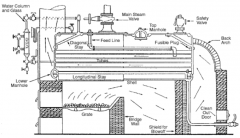
What type of boiler is this? |
HRT Boiler - Firetube |
|
|
Describe Locomotive Type Boilers |
Have a internally-fired firebox surrounded by waterlegs on 4 sides with a capacity of 6800 kg/h at 2400 kPa |
|
|
Pros of Locomotive Type Boilers |
- Suitable for portable services in heating plants, small industrial plants, and the oil field industry - Generally inexpensive to construct |
|
|
Cons of Locomotive Type Boilers |
- Require a large amount of staying - Have poor water circulation - Are difficult to maintain - Provide poor cleaning and inspection access |
|
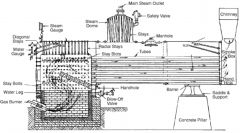
What type of boiler is this? |
Dry Bottom Locomotive Boiler - Firetube Waterleg extends only down the sides |
|
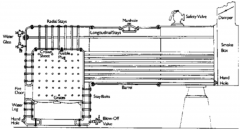
What type of boiler is this? |
Wet Bottom Locomotive Boiler - Firetube Waterleg encloses the bottom of the furnace |
|
|
Describe Firebox Boilers |
Externally-fired, two-pass, horizontal firetube boiler with a shell made in two sections and two groups of firetubes where the combustion gases travel from the firebox, through tubes in the lower shell section to the rear of the boiler where they reverse through the tubes in the upper shell section to the chimney. Usually surrounded by a brick setting enclosed in a steel casing and can have a capacity of 6800 kg/h up to 1720 kPa. |
|
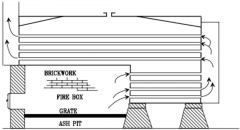
What type of boiler is this? |
Firebox Boiler - Firetube |
|
|
Describe Scotch Marine Boiler |
Horizontal, internally-fired, firetube boiler that incorporates a corrugated furnace that allows for differential expansion between the furnace tube and fire tubes, thus reducing stress on the tubesheets and increasing the strength of the furnace while allowing the wall to be thinner which improves heat transfer. Large furnace tube is surrounded by water and provides additional heating surface. Those with waterlegs were designed for use in a marine service application. |
|
|
Pros of Firebox Boilers |
- Compact - Efficient - Initially inexpensive |
|
|
Cons of Firebox Boilers |
- May be difficult to access for cleaning and inspection |
|
|
Pros of Scotch Marine Boilers |
- Compact - Efficient - Low cost |
|
|
Cons of Scotch Marine Boilers |
- May be difficult to access for cleaning and inspection |
|
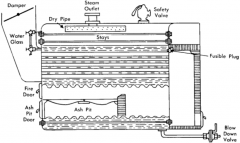
What type of boiler is this? |
Scotch Dryback Boiler - Firetube |
|
|
Describe Heating Boilers |
Same as firetube power boilers except that they operate at a lower pressure with steam heating boilers not exceeding 100 kPa and hot water heating boilers not exceeding 120oC and 1100 kPa. When used in hot water service, a forced circulation pump is usually necessary to maintain even heat distribution inside the boiler. |
|
|
Describe Vertical Firetube Boilers |
Similar to horizontal firetube boilers except that the firetubes run vertically from the furnace to the chimney. Lowest part is the combustion chamber or furnace; the upper part is the actual boiler filled with water. The combustion gases travel upward through the firetubes and are collected by a flue gas collector box connected to the chimney. Baffles made of thing steel stripes are installed inside the tubes which give the gases a swirling motion. Water returning from the heating system is forced into the lower part of the boiler shell by a circulating pump. The water then flows upward around the tubes, pick up heat from the tube walls, leaves the boiler through the top outlet and goes back to the heating system. SIngle pass. |
|
|
Pros of Vertical Firetube Boilers |
- Useful when floor space is limited as boiler occupies only a small area |
|
|
Describe Packaged Firetube Boilers |
The majority of boilers made and can range from two-pass to four-pass Scotch Boiler type and can either be dryback or wetback. Engineered, built, and fire tested before shipment. It comes completely equipped unit mounted on its own base, ready for operation as soon as it is placed in the boiler room and hooked up to the various supply and discharge piping. |
|
|
Pros of Packaged Boilers |
- Can be mass produced which reduces production costs and makes it lower in first cost than a boiler of the same capacity assembled at the site - Better workmanship as assembly is done by more experienced and qualified personnel - Require much smaller floor space, building volume and height - Can be put to use in a shorter length of time after shipping as it can be levelled quickly and only requires a reinforced, flat concrete slab as a foundation - Most are easily accessible for cleaning, inspection and repair due to hinged doors at the front and rear - Doors can be opened by taking out a few bolts, thus making inspection or repair easier and more convenient - Less susceptible to failure due to errors made in water treatment |

